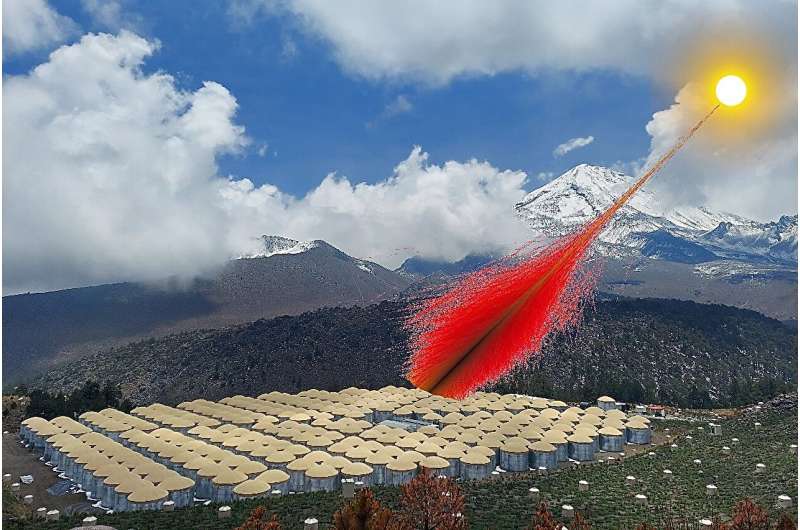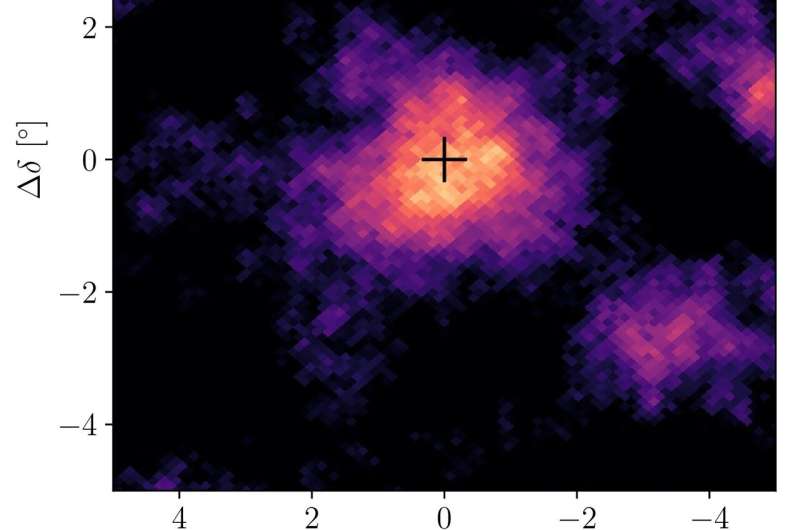This article has been reviewed according to Science X's editorial process and policies. Editors have highlighted the following attributes while ensuring the content's credibility:
fact-checked
peer-reviewed publication
trusted source
proofread
Scientists discover the highest-energy light coming from the sun

Sometimes, the best place to hide a secret is in broad daylight. Just ask the sun.
"The sun is more surprising than we knew," said Mehr Un Nisa, a postdoctoral research associate at Michigan State University. "We thought we had this star figured out, but that's not the case."
Nisa, who will soon be joining MSU's faculty, is the corresponding author of a new paper in the journal Physical Review Letters that details the discovery of the highest-energy light ever observed from the sun.
The international team behind the discovery also found that this type of light, known as gamma rays, is surprisingly bright. That is, there's more of it than scientists had previously anticipated.
Watching like a HAWC
Although the high-energy light doesn't reach the Earth's surface, these gamma rays create telltale signatures that were detected by Nisa and her colleagues working with the High-Altitude Water Cherenkov Observatory, or HAWC.
HAWC is an important part of the story. Unlike other observatories, it works around the clock.
"We now have observational techniques that weren't possible a few years ago," said Nisa, who works in the Department of Physics and Astronomy in the College of Natural Science.
"In this particular energy regime, other ground-based telescopes couldn't look at the sun because they only work at night," she said. "Ours operates 24/7."
In addition to working differently from conventional telescopes, HAWC looks a lot different from the typical telescope.
Rather than a tube outfitted with glass lenses, HAWC uses a network of 300 large water tanks, each filled with about 200 metric tons of water. The network is nestled between two dormant volcano peaks in Mexico, more than 13,000 feet above sea level.
From this vantage point, it can observe the aftermath of gamma rays striking air in the atmosphere. Such collisions create what are called air showers, which are a bit like particle explosions that are imperceptible to the naked eye.
The energy of the original gamma ray is liberated and redistributed among new fragments consisting of lower energy particles and light. It's these particles—and the new particles they create on their way down—that HAWC can "see."
When the shower particles interact with water in HAWC's tanks, they create what's known as Cherenkov radiation that can be detected with the observatory's instruments.
Nisa and her colleagues began collecting data in 2015. In 2021, the team had accrued enough data to start examining the sun's gamma rays with sufficient scrutiny.
"After looking at six years' worth of data, out popped this excess of gamma rays," Nisa said. "When we first saw it, we were like, 'We definitely messed this up. The sun cannot be this bright at these energies.'"

Making history
The sun gives off a lot of light spanning a range of energies, but some energies are more abundant than others.
For example, through its nuclear reactions, the sun provides a ton of visible light—that is, the light we see. This form of light carries an energy of about 1 electron volt, which is a handy unit of measure in physics.
The gamma rays that Nisa and her colleagues observed had about 1 trillion electron volts, or 1 tera electron volt, abbreviated 1 TeV. Not only was this energy level surprising, but so was the fact that they were seeing so much of it.
In the 1990s, scientists predicted that the sun could produce gamma rays when high-energy cosmic rays—particles accelerated by a cosmic powerhouse like a black hole or supernova—smash into protons in the sun. But, based on what was known about cosmic rays and the sun, the researchers also hypothesized it would be rare to see these gamma rays reach Earth.
At the time, though, there wasn't an instrument capable of detecting such high-energy gamma rays and there wouldn't be for a while. The first observation of gamma rays with energies of more than a billion electron volts came from NASA's Fermi Gamma-ray Space Telescope in 2011.
Over the next several years, the Fermi mission showed that not only could these rays be very energetic, but also that there were about seven times more of them than scientists had originally expected. And it looked like there were gamma rays left to discover at even higher energies.
When a telescope launches into space, there's a limit to how big and powerful its detectors can be. The Fermi telescope's measurements of the sun's gamma rays maxed out around 200 billion electron volts.
Theorists led by John Beacom and Annika Peter, both professors at Ohio State University, encouraged the HAWC Collaboration to take a look.
"They nudged us and said, "We're not seeing a cutoff. You might be able to see something," Nisa said.
The HAWC Collaboration includes more than 30 institutions across North America, Europe and Asia, and a sizable portion of that is represented in the nearly 100 authors on the new paper. That includes Michigan state University graduate student Daniel Salazar-Gallegos, Professor Emeritus James Linnemann and Kirsten Tollefson, a professor of physics and astronomy and associate dean in the Graduate School at MSU.
Now, for the first time, the team has shown that the energies of the sun's rays extend into the TeV range, up to nearly 10 TeV, which does appear to be the maximum, Nisa said.
Currently, the discovery creates more questions than answers. Solar scientists will now scratch their heads over how exactly these gamma rays achieve such high energies and what role the sun's magnetic fields play in this phenomenon, Nisa said.
When it comes to the cosmos, though, that's part of the excitement. It tells us that there was something wrong, missing or perhaps both when it comes to how we understand our nearest and dearest star.
"This shows that HAWC is adding to our knowledge of our galaxy at the highest energies, and it's opening up questions about our very own sun," Nisa said. "It's making us see things in a different light. Literally."
More information: A. Albert et al, Discovery of Gamma Rays from the Quiescent Sun with HAWC, Physical Review Letters (2023). DOI: 10.1103/PhysRevLett.131.051201
Journal information: Physical Review Letters
Provided by Michigan State University




















